
All images © by Roberto Piperno, owner of the domain. Write to romapip@quipo.it.
Notes:
Page added in March 2020. Photos taken in June 2014 and February 2020.

All images © by Roberto Piperno, owner of the domain. Write to romapip@quipo.it.
Notes:
Page added in March 2020. Photos taken in June 2014 and February 2020.
 - Tombs
- TombsYou may wish to read a page on the town first.
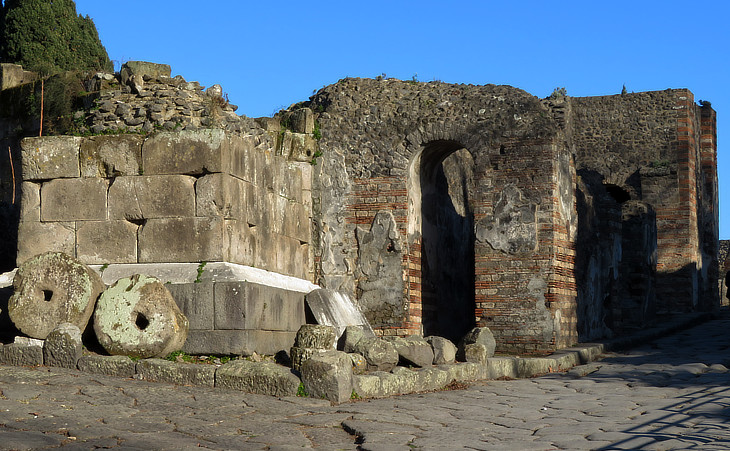
Northern part of Porta Ercolano and an unfinished tomb outside it
I was next conducted through a large track of vine-yard to a cavity of considerable extent, which has laid
open part of a principal street, one of the city gates, a length of wall, some tombs, and a road without the gates.
Henry Swinburne - Travels in the Two Sicilies. 1777-1780
Pompeii complied with the Roman law which did not allow tombs within the walls of the town. The necropolis found outside Porta Ercolano is
the largest one and it retains some fine tombs. They were made popular across Europe as early as 1789 by etchings by Francesco Piranesi, son of Giovanni Battista (you may wish to see one of them - it opens in another window).

Tombs of C. Calventius Quietus and C. Munatius Faustus outside Porta Ercolano (see a 1909 painting by Alberto Pisa showing the Street of the Tombs)
The traveller will leave the railway branch at the Pompeii
station, which is near the quarter of
the Forum, and is about equidistant
from the two main entrances to the
city. The best plan, if this route be
followed, is to walk or ride from the
station to the old road, which will
enable him to enter the city by the
Street of the Tombs and quit it by the
modern entrance at the barracks. (..) On either side
the street is bordered by tombs of every
variety of form and taste, recalling to
our imagination the ancient glories of
the Appian as it once emerged from
the Eternal City upon the Campagna.
John Murray - Handbook for Travellers in Southern Italy - 1853

Details of the tombs of C. Calventius Quietus (left) and C. Munatius Faustus (right), two citizens
having right to a "bisellium", a folding seat at the theatre (see similar tombs at Herculaneum and Verona)
The funerary monuments of Pompeii, similar to those of Rome (e.g. Tomb of Marcus Virgilius Eurysaces),
provide interesting data about the economic and political life of the town. The inscription in the first monument reads:
"To Caius Calventius Quietus, Augustalis. On account of his munificence he is honoured with a bisellium by decree of the decurions
and with the consensus of the people." The second one shows a ship at sail which most likely was owned by the dead.
The relief on the other
side is a very curious representation
of a ship entering port. (..) This
interesting sculpture, which would
make a beautiful subject for a seal, is
supposed to have a double meaning,
first as a memorial of the commercial
pursuits of Munatius; and secondly as
illustrative of the last scene of the
voyage of life, when the soul enters
into a safe and peaceful haven. (a similar message can be seen in a funerary mosaic at the Great Necropolis of Porto). (..) Crossing again to the right
side of the street, we find an inclosure
leading to a vast court with a portico (..) it is now (..) regarded as one
of the courts of the adjoining villa,
which has been dignified by the
name of Cicero. He tells us, indeed
in many of his letters, that he had a
villa in the neighbourhood of Pompeii;
but there is no proof that it was this
one. (..) Some of the finest paintings and mosaics in the Museo Borbonico were
found among its ruins, including the (..) mosaics which bear the
name of Dioscorides of Samos. Murray

Tomb of Priestess Mamia outside Porta Ercolano (see a 1909 painting by A. Pisa showing the Tomb)
The tomb of a priestess, a semicircular bench, with a stone
back, on which was the inscription cut in large characters.
Over the back you have a sight of the sea and the setting sun
- a glorious spot, worthy of the beautiful idea.
J. W. Goethe - Italian Journey - March 13, 1787 - translation by Charles Nisbet
It may be observed that the great approaches
to the cities were not marked by tombs alone, but partly by suburban villas, and tradesmen's
houses, and semicircular seats. Thus they were
frequented as public walks, and the beauty of
the sepulchres, together with the religion of
the people, and the wisdom of the higher orders,
prevented any melancholy reflections from being
suggested by the receptacles of the dead. Those
who have seen the street of the tombs at Pompej will feel the truth of this observation.
John Cam Hobhouse - Dissertations on the Ruins of Rome - 1818
Priestesses could achieve a very high status in Ist century AD Pompeii. The tomb of Mamia, one of them,
has always attracted the attention of visitors for the semicircular bench where funerary banquets took place. Wilhelm Tischbein, a painter who accompanied Goethe to Pompeii, portrayed Duchess Anna Amalia of Brunswick-Wolfenbüttel
sitting on the bench (it opens in another window).
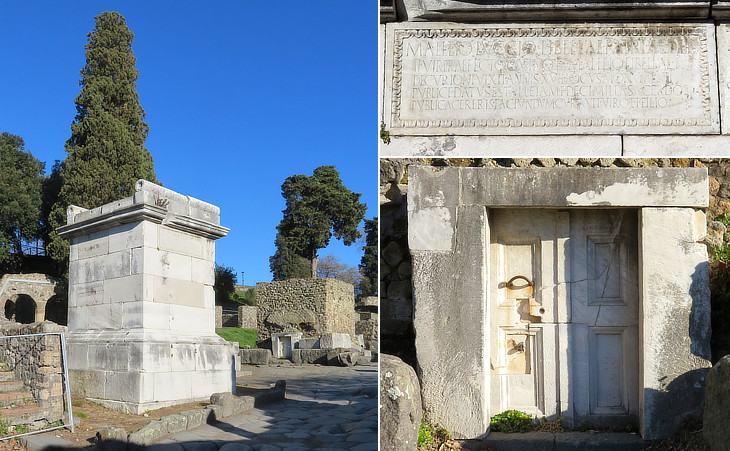
(left) Tomb of the Libella; (right-above) its inscription; (right-below) decorative marble door of the next tomb which was excavated in 1813
Tomb of the Libella, a solid and very
elegant tomb, built of blocks of travertine resembling the pedestal of a
column, 16 feet high with a moulding
and cornice, and a long inscription,
recording its erection on a site given
by the public, by Alleia Decimilla,
public priestess of Ceres, to her husband and son, Marcus Alleius Lucius
Libella the father, aedile, duumvir,
and quinquennial praefect, and M.
Alleius Libella the son, decurion, who
lived 17 years. Near this are a small
square enclosure, and another tomb,
both of them either half finished or ruined. Murray
The long inscription shows that the Allei were a very important family; father and son held positions in the administration of the town and the mother was a priestess.
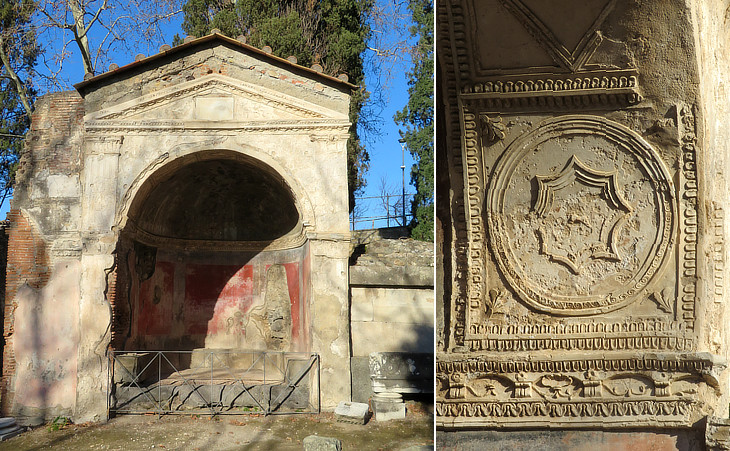
(left) Unnamed "schola tomb" (and to its right Tomb of the Blue Vase/Glass Amphora); (right) detail of its stucco decoration
The Hemicycle tomb is a deep semicircular seat or esedra, with a vaulted
roof ornamented in front by pilasters
in two rows, the upper ones springing
out of the capitals of the lower. The
walls and vault were gaily painted
in arabesques and panels. Near it
were found the skeletons of a mother
and three children, one of them an infant, all closely folded in each other's
arms, and covered with gold ornaments
elaborately worked, and enriched with
pendant pearls of great value.
Tomb of the Glass Amphora,
near the Hemicycle, remarkable for an
amphora of blue glass with white
figures which was found in it.
Murray
Schola tombs are unique to Pompeii. The Hemicycle tomb is a rare entire example of this building, because in general archaeologists found only the semicircular bench. The term schola (after which school) in origin indicated a place where to rest, in this case to attend funerary ceremonies.
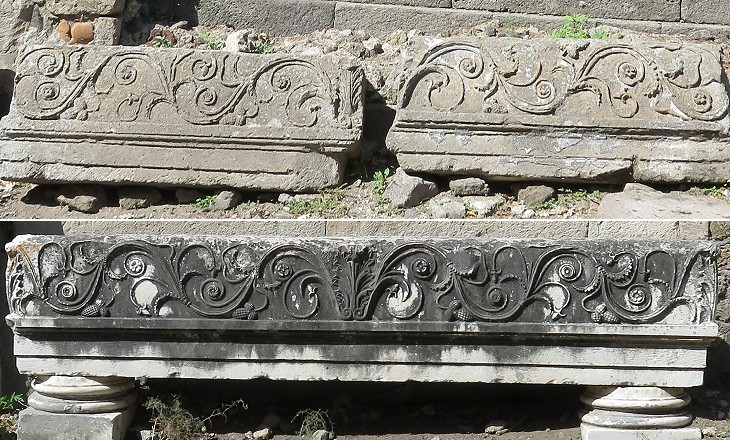
Details of tombs with a decoration based on acanthus leaves and acorns: (above) Tomb of the Garlands; (below) Tomb of the Blue Vase
Tomb of the Garland, on a
lofty basement, with Corinthian pilasters sustaining festoons of flowers. Murray
In 1812 François Mazois, an architect at the court of Joaquim Murat, King of Naples and brother-in-law of Napoleon, began to draw the monuments of Pompeii. His works were eventually published in 1824-1838 in Les ruines de Pompéi. He carefully copied the decorations of the tombs outside Porta Ercolano. Those carved in stone, by and large, are still there, but many stucco reliefs are lost.
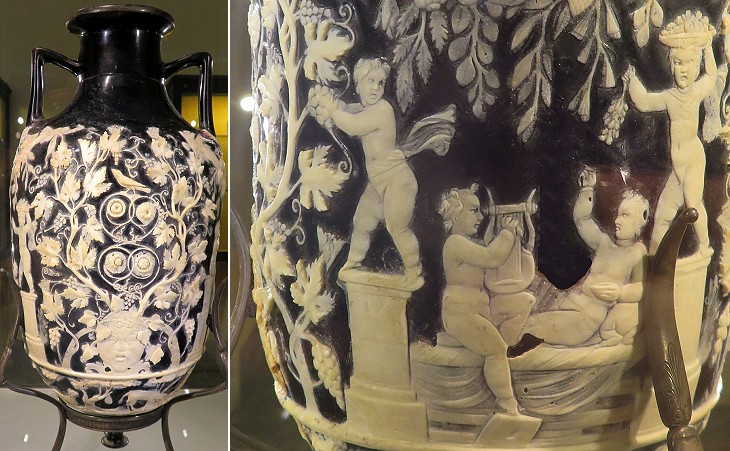
Archaeological Museum of Naples: the "Blue Vase"; it was found in 1837 in the presence of King Ferdinand I
This beautiful vase was found in a small unassuming tomb. It testifies to the wealth and taste of the inhabitants of Pompeii who were prepared to part with such an exquisite object to honour their dead. It depicts a group of putti gaily harvesting grapes for winemaking and playing musical instruments, an early example of a subject which will remain popular for centuries, also among the early Christians. You may wish to see the very similar Portland Vase which was found in Rome in the XVIth century.
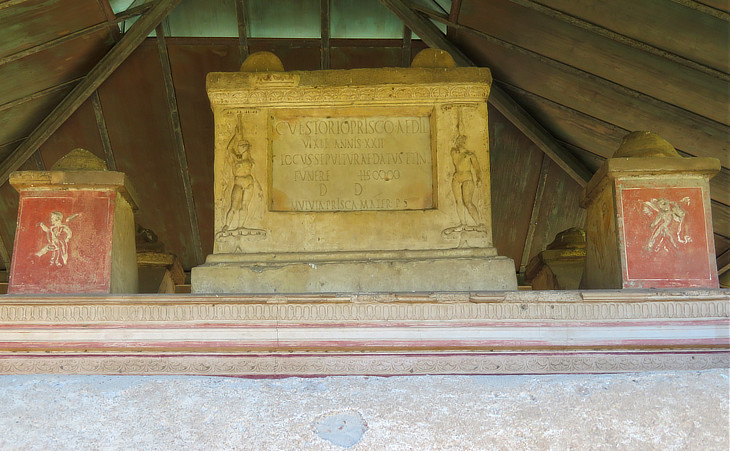
Tomb of Caius Vestorius Priscus outside Porta Vesuvio
Necropolises were eventually discovered also outside the other gates of Pompeii; that at Porta Vesuvio was excavated in 1907-1910 only in the vicinity of the gate; tombs might still lay under the vineyards outside the archaeological area. The most interesting tomb has small decorated altars above a large and tall basement. It is dedicated to an aedile, an officer in charge of public buildings, who died at the age of 22. The tomb has other paintings inside the basement which contains the funerary room.
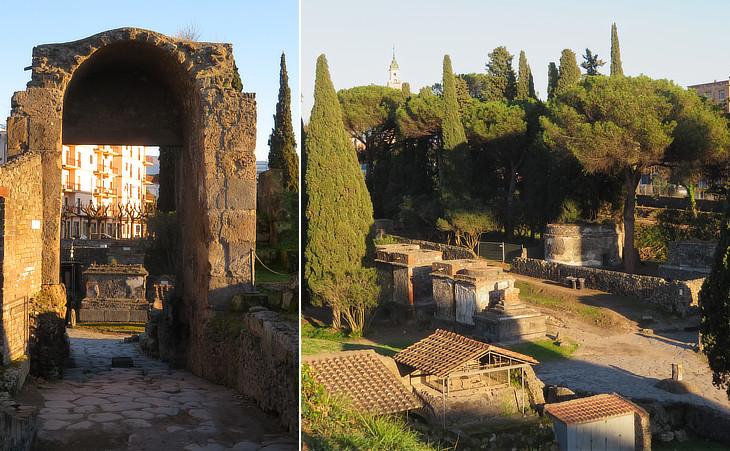
(left) Porta Nocera; (right) Necropolis of Porta Nocera
This necropolis was excavated in the 1950s and efforts were made to enhance its evocativeness, which gains from the site not being much frequented, unlike the necropolis outside Porta Ercolano. Some seventy tombs are aligned along a road which was parallel to the walls. As usual in Italian archaeological areas pines and cypresses were planted along the road, a practice which was introduced by Giacomo Boni when he excavated the Palatine hill.
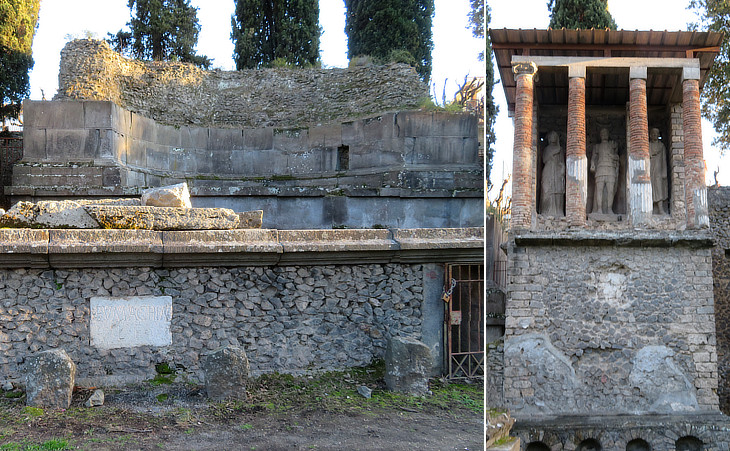
(left) Tomb of Eumachia; (right) Tomb of Marcus Octavius
Archaeologists were excited when they discovered that a schola tomb was built by priestess Eumachia to whom a large building was dedicated in the Forum. They found two inscriptions "EUMACHIA L(uci) F(ilia)" and "SIBI ET SUIS" which indicated that the tomb was meant also for members of her enlarged family, by this meaning a number of freedmen and freedwomen, for a total of at least 13.
Marcus Octavius has been identified as a veteran who settled in the town after it had been conquered by Silla in 89 BC, thus his tomb is among the oldest ones. The statues of a woman, a soldier and an old man stand in a temple-like portico, while four niches in the lower part of the monument housed small busts.
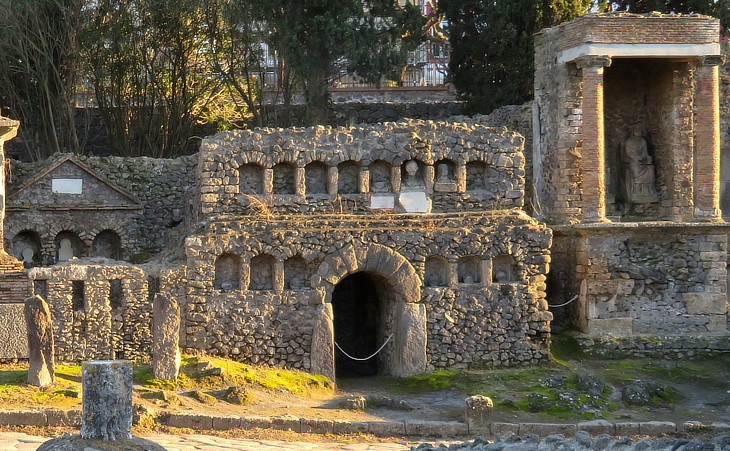
Other tombs at the Necropolis of Porta Nocera with statues, niches and busts, one of which is shown in the image used as background for this page
Move to:
The Town
Temples and Religion
Public Buildings near the Forum
Other Public Buildings
Houses
Paintings
Other Works of Art
The Economy
Villa di Poppea at Oplontis
Pompeii in the 1909 paintings by Alberto Pisa

